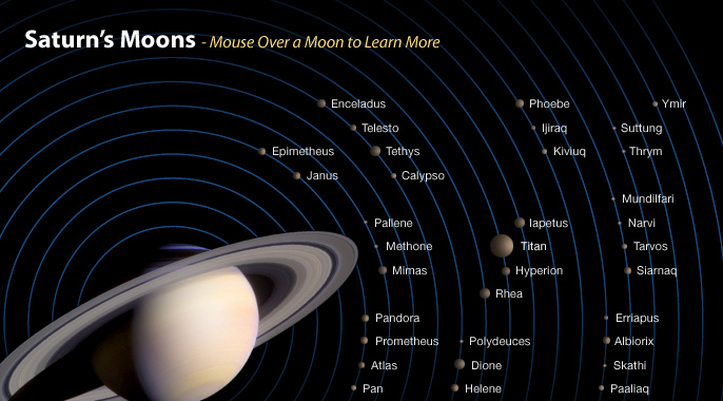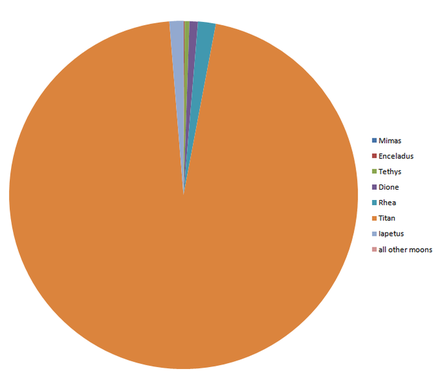Our Solar System
Saturn's Moon

The dozens of icy moons orbiting Saturn vary drastically in shape, size, surface age and origin. Some of these worlds have hard, rough surfaces, while others are porous bodies coated in a fine blanket of icy particles. All have greater or smaller numbers of craters, and many have ridges and valleys. Some, like Dione and Tethys, show evidence of tectonic activity, where forces from within ripped apart their surfaces. Many, like Rhea and Tethys, appear to have formed billions of years ago, while others, like Janus and Epimetheus, could have originally been part of larger bodies that broke up. The study and comparison of these moons tells us a great deal about the history of the Saturn System and of the solar system at large.
Saturn has 62 moons with confirmed orbits, as of March 2011. 53 have been named and 9 are provisional. These are as follows:
Moons:
Aegaeon, Aegir, Albiorix, Anthe, Atlas, Bebhionn, Bergelmir, Bestla, Calypso, Daphnis, Dione, Enceladus, Epimetheus, Erriapus, Farbauti, Fenrir, Fornjot, Greip, Hati, Helene, Hyperion, Hyrokkin, Iapetus, Ijiraq, Jarnsaxa, Janus, Kari, Kiviuq, Loge, Methone, Mimas, Mundilfari, Narvi, Paaliaq, Pallene, Pan, Pandora, Phoebe, Polydeuces, Prometheus, Rhea, Suttungr, Skathi, Siarnaq, Surtur, Tarqeq, Tarvos, Telesto, Tethys, Thrymr, Titan, Ymir
Provisional:
S/2004 S 7
S/2004 S 12
S/2004 S 13
S/2004 S 17
S/2006 S 1
S/2006 S 3
S/2007 S 2
S/2007 S 3
S/2009/S 1
There are countless pieces (of varying materials, sizes, densities, masses, and life expectancies) orbiting Saturn. What is lacking, is consensus on a clear, definition of the term, moon.
Saturn has 62 moons with confirmed orbits, as of March 2011. 53 have been named and 9 are provisional. These are as follows:
Moons:
Aegaeon, Aegir, Albiorix, Anthe, Atlas, Bebhionn, Bergelmir, Bestla, Calypso, Daphnis, Dione, Enceladus, Epimetheus, Erriapus, Farbauti, Fenrir, Fornjot, Greip, Hati, Helene, Hyperion, Hyrokkin, Iapetus, Ijiraq, Jarnsaxa, Janus, Kari, Kiviuq, Loge, Methone, Mimas, Mundilfari, Narvi, Paaliaq, Pallene, Pan, Pandora, Phoebe, Polydeuces, Prometheus, Rhea, Suttungr, Skathi, Siarnaq, Surtur, Tarqeq, Tarvos, Telesto, Tethys, Thrymr, Titan, Ymir
Provisional:
S/2004 S 7
S/2004 S 12
S/2004 S 13
S/2004 S 17
S/2006 S 1
S/2006 S 3
S/2007 S 2
S/2007 S 3
S/2009/S 1
There are countless pieces (of varying materials, sizes, densities, masses, and life expectancies) orbiting Saturn. What is lacking, is consensus on a clear, definition of the term, moon.
Saturn Moon Sizes

The Saturnian moon system is very lopsided: one moon, Titan, comprises more than 96% of the mass in orbit around the planet. The six other oblate moons constitute roughly 4%, while the remaining 54 small moons, together with the rings, comprise only 0.04% (The mentioned moon name details are provided)
